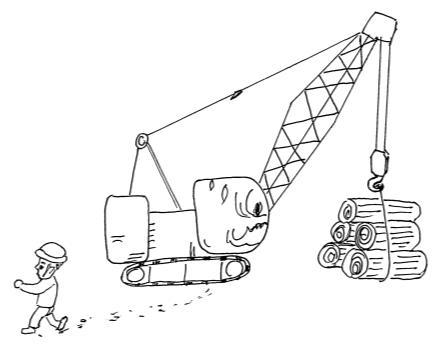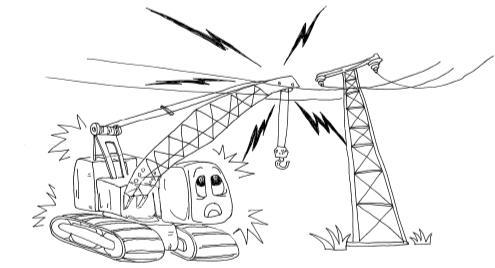
6 minute read
履带起重机操作手册
– At least 33ft (10 m) in the case of a high-voltage cable, or if uncertain about the voltage of the underground cable.
4) Inform the relevant power station of the accident. Prevent access to the area around the fault location: fence off an area with a radius of 33ft (10 m).
5) Thoroughly inspect the machine before resuming operation.
d) If the control no longer functions, use the radio or call
1) To everyone in the vicinity not to come any closer to or touch the machine, the hoisting rope or load; tell them to keep at least 33ft (10 m) away.
2) To arrange for the power lines to be switched off by the relevant power station.
Caution
Only leave the driver’s cab if you have reliable confirmation that the underground cable has been switched off.
Danger
Even an underground cable that has been switched off can be switched on again manually, or by automatic safety devices, for fault detection purposes.
履带起重机操作手册
Operator’s Manual for Crawler Crane
Operator’s Manual for Crawler Crane
3.8 Checking safety measures
3.8.1 Daily inspection of the crane
The crane must be checked daily to ensure safe and good state, the items to be inspected includes: a) Check the daily record of work to ensure that all regular inspections, maintenance, and repair work have been performed. b) Check the lowering limiter, the boom angle indicator, the tilting-back supports, and other safety devices for functional operation. c) Check the load-bearing parts carefully, such as the wire rope (the hoisting rope, the derricking rope, and the anchoring rods etc), the boom frame, the outriggers, and the load hook. d) Check if there are missing bolts, nuts, and pins, and if the components are cracked or damaged. e) Ensure that no modification has been made to the crane without permission, for example, an increase or decrease in general counterweight or improper repair of boom frame. f) Check the fuel lines and the hydraulic oil lines for leakage. g) Check if the values shown on the instruments are correct after starting up the engine. h) Check if the control mechanisms are working normally. i) Check the brake and the clutch Test the braking performance by lifting a load away from the ground and holding it in the air for a moment. j) Check if there lacks lubricant, grease or antifreeze fluid k) Check if sundries accumulate too much.
Danger
Check the crane daily for safety and familiarize yourself with the potential dangers brought by the work.
3.8.2 Safety checking before crane operation
The safety condition of the crane should be checked thoroughly prior to operating the crane, including: a) Check whether the ground provides adequate load-bearing capacity b) Check whether there is sufficient safety clearance to slopes and trenches c) Check whether the crane is adjusted to be horizontal d) Check whether there are live electrical wires within the working range of the crane e) Check whether there are obstacles which will hinder required crane operation
Caution
The crane operation belongs to dangerous operation; so much attention should be given to the working condition of the crane before and during crane operation.
ZCC1100H Crawler Crane 3-39
3.9 Crane operation with a load
Operator’s Manual for Crawler Crane
履带起重机操作手册
Before beginning any work, the crane operator must be convinced that the crane is in safe operating condition. All safety devices, such as load moment limiter, hoist limiter switches, and brakes, etc., are in good working order.
a) The load moment limiter must be set according to the current crane configuration.
b) The lifting height of crane as given in the load capacity charts must be adhered to. The load given in the load capacity charts must not be exceeded during operation c) The crane operator must know the weight and dimensions of the load before operating the crane. d) Lifting device, slings and fixed pulley block must be set in accordance with specified safe operation requirements. e) Make sure that the total weights of lifting device, wire rope and the actually lifted load won’t exceed the rated lifting capacity, referring to table 3-7
Table 3-7
Calculation of lifting capacity
3.9.1 Counterweight
Extend the crawler carrier fully, then we can get that the weight of the rear counterweight is 61740 lb (28 t) and that of central counterweight is 22050lb (10 t)
Danger
If the counterweight is not installed properly according to the lifting capacity chart, there is a danger of the crane toppling over.
履带起重机操作手册
Operator’s Manual for Crawler Crane
Operator’s Manual for Crawler Crane
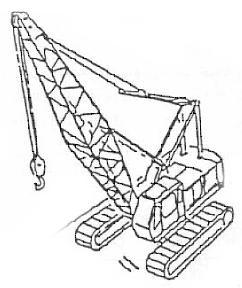
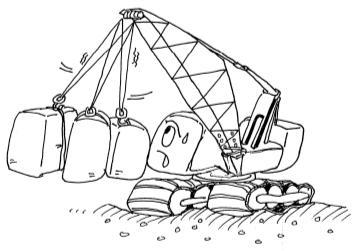
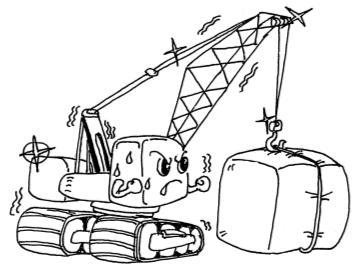
3.9.2 Crane operation
3.9.2.1 Operating conditions
The crane must satisfy the conditions in the table 3-8 when working.
Table 3-8 Operating conditions
No. Conditions
1
All components of crane are in running-in state at the initial operating period. So, for the first 100 operating hours, the working load should not be too great and the working speed should not be too fast. The maximum lifting load can not exceed 80% of its rated load. And the maximum working speed is forbidden.
Examples
2
The ground on job site should be firm and flat and the gradient should not be greater than 1/100. The complete vehicle should be level and the supporting ground should not be sunken during operating. If the ground is soft, a steel plate should be placed under the track pad
3
The permitted temperature range for crane operation is -20℃ – 40℃. Relative humidity should not exceed 85%; however, high humidity up to 100% is only permitted for a short period of time. The crane should be operated and supported on a ground lower than 1000m above seal level.
4
The maximum in-service wind velocity should be not more than 9.8m/s during operation; the maximum out-of-service wind velocity should be no more than 21m/s when only main boom is assembled, and no more than 15m/s when fixed jib is assembled. Please refer to table 3-8 to estimate the wind velocity more accurately.
ZCC1100H Crawler Crane 3-41
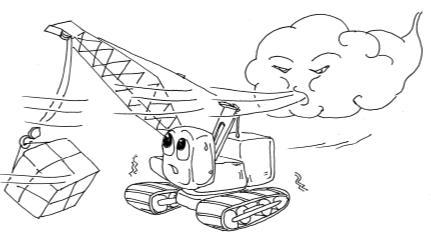
Operator’s Manual for Crawler Crane
履带起重机操作手册
No. Conditions Examples
5
When the crane is working near the high-voltage power line, the safe clearance between any part of the crane and overhead power line should comply with regulations in table 3-9.
6
Only the crane without fault is allowed to work.
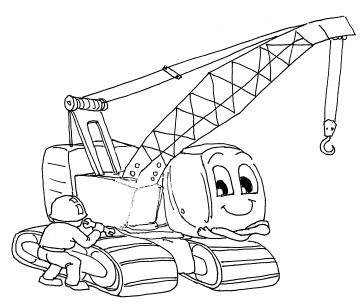
Wind force Effects of the wind in the inland Beaufort
No wind, smoke rises straight up 1
Wind direction is shown only by observing the trail of smoke, not by the wind sock 2
Wind can be felt on the face, the leaves rustle, wind sock moves slightly 3
Leaves and thin twigs move. Wind extends a small breeze flag.
Swirls up dust and loose paper, moves twigs and thin branches
Small deciduous trees begin to sway, foam forms
Thicker branches move; telephone lines begin to whistle, umbrellas are difficult to use
Entire trees swaying; difficult to walk into wind
Breaks twigs off trees, walking becomes difficult
Minor damage to property(chimney tops and roofing tile are blown off)
Trees are uprooted, significant damage to property
ZCC1100H Crawler Crane
1
Operator’s Manual for Crawler Crane
Operator’s Manual for Crawler Crane
履带起重机操作手册
3.9.2.2 Instructions for safe operation
The instructions for safe operation during crane operation are shown in the table 3-11
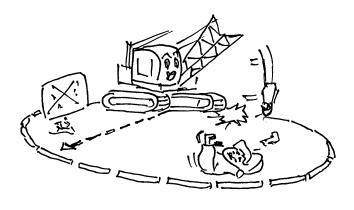
Table 3-11 Instructions for safe operation
No person is allowed to stand under the boom or on the slewing table when the crane is operated.
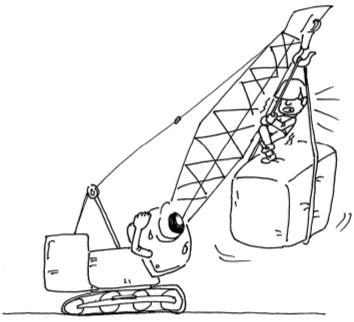

2 It is forbidden to lift load over people.
3
It is forbidden to lift the load when someone stands on it.
4
Overloading operation and lifting staggered load is prohibited. Never pull load obliquely.
ZCC1100H Crawler Crane 3-43
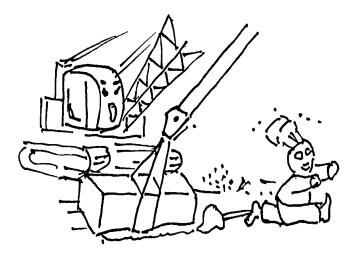
S/N Instructions
5
It is forbidden to lift the load hidden in the ground or frozen on the ground.
6
The crane can travel with a load of 100% of the rated load when the gradient is equal to or less than1/100 and the travelling speed is less than 0.4 kmph. In this case, the boom frame must be located in the driving direction. The distance from the load to the ground should be less than 50cm. The longer the boom, the slower the travelling speed. Meanwhile, the distance from the load to the ground should be as low as possible.
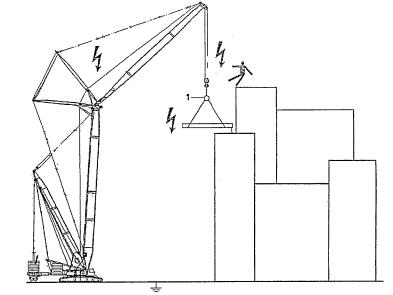
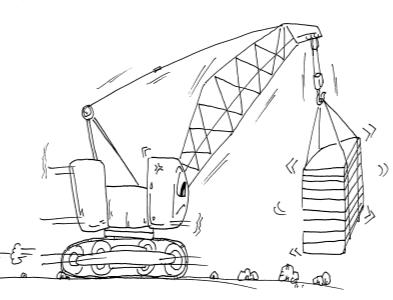
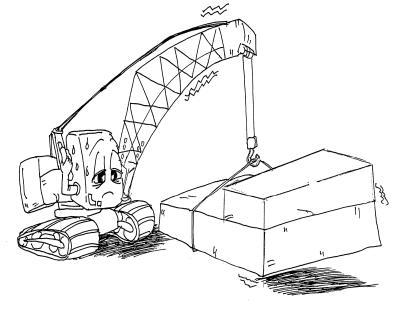
7
If the crane is operated in the vicinity of transmission systems (e.g. transmitters), strong electromagnetic field will be generated there, so measures should be taken to protect the crane against high frequency interference and all workers who stand on large metal plates should wear special isolating gloves and clothes to avoid being burnt.
8
The brake of hoisting winch can not be adjusted when the crane is lifting a load.
Operator’s Manual for Crawler Crane
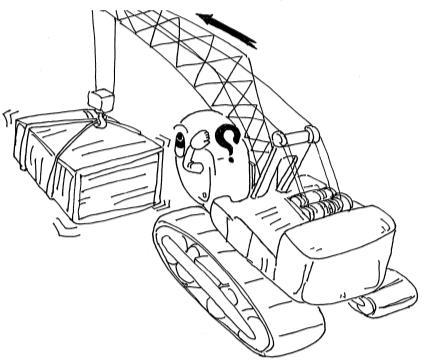
履带起重机操作手册
Examples
9
10
11
12
13
Operator’s Manual for Crawler Crane
Operator’s Manual for Crawler Crane
